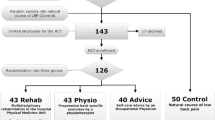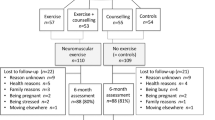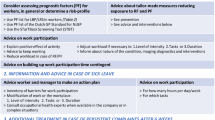Abstract
Introduction Low back pain (LBP) is one of the most costly conditions to manage in occupational health. Individuals with chronic or recurring LBP experience difficulties returning to work due to disability. Given the personal and financial cost of LBP, there is a need for effective interventions aimed at preventing LBP in the workplace. The aim of this systematic review was to examine the effectiveness of exercises in decreasing LBP incidence, LBP intensity and the impact of LBP and disability. Methods A comprehensive literature search of controlled trials published between 1978 and 2007 was conducted and a total of 15 studies were subsequently reviewed and analyzed. Results There was strong evidence that exercise was effective in reducing the severity and activity interference from LBP. However, due to the poor methodological quality of studies and conflicting results, there was only limited evidence supporting the use of exercise to prevent LBP episodes in the workplace. Other methodological limitations such as differing combinations of exercise, study populations, participant presentation, workloads and outcome measures; levels of exercise adherence and a lack of reporting on effect sizes, adverse effects, and types of sub-groups, make it difficult to draw definitive conclusions on the efficacy of workplace exercise in preventing LBP. Conclusions Only two out of the 15 studies reviewed were high in methodological quality and showed significant reductions in LBP intensity with exercise. Future research is needed to clarify which exercises are effective and the dose-response relationships regarding exercise and outcomes.
Similar content being viewed by others
References
Frymoyer JW. Back pain and sciatica. N Engl J Med. 1988;318(5):291–300.
Krismer M, van Tulder M. Low back pain (non-specific). Best Pract Res Clin Rheumatol. 2007;21(1):77–91. doi:10.1016/j.berh.2006.08.004.
Bergman S. Management of musculoskeletal pain. Best Pract Res Clin Rheumatol. 2007;21(1):153–66. doi:10.1016/j.berh.2006.10.001.
Truchon M. Determinants of chronic disability related to low back pain: towards an integrative biopsychosocial model. Disabil Rehabil. 2001;23:758–67. doi:10.1080/09638280110061744.
Hashemi L, Webster BS, Clancy EA, Volinn E. Length of disability and cost of workers’ compensation low back pain claims. J Occup Environ Med. 1997;39(10):937–45. doi:10.1097/00043764-199710000-00005.
van Mechelen W, Twisk J, Molendijk A, Blom B, Snel J, Kemper HC. Subject-related risk factors for sports injuries: a 1-yr prospective study in young adults. Med Sci Sports Exerc. 1996;28(9):1171–9. doi:10.1097/00005768-199609000-00014.
Crook J, Milner R, Schultz IZ, Stringer B. Determinants of occupational disability following a low back injury: a critical review of the literature. J Occup Rehabil. 2002;12(4):277–95. doi:10.1023/A:1020278708861.
Hartvigsen J, Lings S, Leboeuf-Yde C, Bakketeig L. Psychosocial factors at work in relation to low back pain and consequences of low back pain; a systematic, critical review of prospective cohort studies. Occup Environ Med. 2004;61(1):e2.
Marras WS, Ferguson SA, Burr D, Schabo P, Maronitis A. Low back pain recurrence in occupational environments. Spine. 2007;32(21):2387–97.
Pincus T, Burton AK, Vogel S, Field AP. A systematic review of psychological factors as predictors of chronicity/disability in prospective cohorts of low back pain. Spine. 2002;27(5):E109–20. doi:10.1097/00007632-200203010-00017.
Hoogendoorn WE, van Poppel MN, Bongers PM, Koes BW, Bouter LM. Systematic review of psychosocial factors at work and private life as risk factors for back pain. Spine. 2000;25(16):2114–25. doi:10.1097/00007632-200008150-00017.
Linton SJ. Occupational psychological factors increase the risk for back pain: a systematic review. J Occup Rehabil. 2001;11(1):53–66. doi:10.1023/A:1016656225318.
Guzmán J, Esmail R, Karjalainen K, Malmivaara A, Irvin E, Bombardier C. Multidisciplinary rehabilitation for chronic low back pain: systematic review. Br Med J. 2001;322(7301):1511–6. doi:10.1136/bmj.322.7301.1511.
Burton AK. European guidelines for prevention in low back pain. Eur Spine J. 2006;15(suppl 2):136. doi:10.1007/s00586-006-1070-3.
Hayden JA, van Tulder MW, Tomlinson G. Systematic review: strategies for using exercise therapy to improve outcomes in chronic low back pain. Ann Intern Med. 2005;142(9):776–85.
Kool J, de Bie R, Oesch P, Knusel O, van den Brandt P, Bachmann S. Exercise reduces sick leave in patients with non-acute non-specific low back pain: a meta-analysis. J Rehabil Med. 2004;36(2):49–62. doi:10.1080/16501970310020104.
Schonstein E, Kenny D, Keating J, Koes B, Herbert RD. Physical conditioning programs for workers with back and neck pain: a cochrane systematic review. Spine. 2003;28(19):E391–5. doi:10.1097/01.BRS.0000092482.76386.97.
van Poppel MNM, Hooftman WE, Koes BW. An update of a systematic review of controlled clinical trials on the primary prevention of back pain at the workplace. Occup Med (Oxford, England). 2004;54(5):345–52. doi:10.1093/occmed/kqh065.
van Tulder M, Malmivaara A, Esmail R, Koes B. Exercise therapy for low back pain: a systematic review within the framework of the cochrane collaboration back review group. Spine. 2000;25(21):2784–96. doi:10.1097/00007632-200011010-00011.
Liddle SD, Baxter GD, Gracey JH. Exercise and chronic low back pain: what works? Pain. 2004;107(1–2):176–90. doi:10.1016/j.pain.2003.10.017.
Hayden JA, van Tulder MW, Malmivaara AV, Koes BW. Meta-analysis: exercise therapy for nonspecific low back pain. Ann Intern Med. 2005;142(9):765–77.
Ferreira PH, Ferreira ML, Maher CG, Herbert RD, Refshauge K. Specific stabilisation exercise for spinal and pelvic pain: a systematic review. Aust J Physiother. 2006;52(2):79–88.
Cusi MF, Butel CJ, Garlick D, Argyrous G. Lumbopelvic stability and injury profile in rugby union players. NZ J Sports Med. 2001;29(1):14–8.
Harringe M, Nordgren J, Arvidsson I, Werner S. Low back pain in young female gymnasts and the effect of specific segmental muscle control exercises of the lumbar spine: a prospective controlled intervention study. Knee Surg Sports Traumatol Arthrosc. 2007;15(10):1264–71. doi:10.1007/s00167-007-0289-9.
Hides JA, Stanton WR, McMahon S, Sims K, Richardson CA. Effect of stabilization training on multifidus muscle cross-sectional area among young elite cricketers with low back pain. J Orthop Sports Phys Ther. 2008;38(3):101–8.
Perich D, Burnett A, O’Sullivan P, Perkin C, editors. Low back pain in adolescent female rowers: a multidisciplinary intervention study. XXIst Congress of the International Society of Biomechanics; 2007 July; Taipei.
O’Sullivan P. “Clinical instability” of the lumbar spine: its pathological basis, diagnosis and conservative management. In: Boyling JD, Jull GA, editors. Grieve’s manual therapy: the vertebral column. Edinburgh: Churchill Livingstone; 2004. p. 311–32.
van Tulder M, Furlan A, Bombardier C, Bouter L. Updated method guidelines for systematic reviews in the cochrane collaboration back review group. Spine. 2003;28(12):1290–9. doi:10.1097/00007632-200306150-00014.
van Tulder MW, Assendelft WJ, Koes BW, Bouter LM. Method guidelines for systematic reviews in the Cochrane collaboration back review group for spinal disorders. Spine. 1997;22(20):2323–30. doi:10.1097/00007632-199710150-00001.
Boutron I, Moher D, Altman DG, Schulz KF, Ravaud P, For the CONSORT group. Methods and processes of the CONSORT group: example of an extension for trials assessing nonpharmacologic treatments. Ann Intern Med. 2008;148(4):W-60–6.
Boutron I, Moher D, Altman DG, Schulz KF, Ravaud P, For the CONSORT Group. Extending the CONSORT statement to randomized trials of nonpharmacologic treatment: explanation and elaboration. Ann Intern Med. 2008;148(4):295–309.
Borkan JM, Koes B, Reis S, Cherkin D. A report from the second international forum for primary care research on low back pain: reexamining priorities. Spine. 1998;23(18):1992. doi:10.1097/00007632-199809150-00016.
Moore A, Jull G. The systematic review of systematic reviews has arrived. Man Ther. 2006;11(2):91–2. doi:10.1016/j.math.2006.04.001.
Hlobil H, Staal JB, Twisk J, Köke A, Ariëns G, Smid T, et al. The effects of a graded activity intervention for low back pain in occupational health on sick leave, functional status and pain: 12-month results of a randomized controlled trial. J Occup Rehabil. 2005;15(4):569–80. doi:10.1007/s10926-005-8035-y.
Staal JB, Hlobil H, Twisk JWR, Smid T, Koke AJA, van Mechelen W. Graded activity for low back pain in occupational health care: a randomized, controlled trial. Ann Int Med. 2004;140(2):77–84.
Amako M, Oda T, Masuoka K, Yokoi H, Campisi P. Effect of static stretching on prevention of injuries for military recruits. Mil Med. 2003;168(6):442–6.
Helmhout PH, Harts CC, Staal JB, Candel MJ, de Bie RA. Comparison of a high-intensity and a low-intensity lumbar extensor training program as minimal intervention treatment in low back pain: a randomized trial. Eur Spine J. 2004;13(6):537–47. doi:10.1007/s00586-004-0671-y.
Dehlin O, Berg S, Andersson GB, Grimby G. Effect of physical training and ergonomic counselling on the psychological perception of work and on the subjective assessment of low-back insufficiency. Scand J Rehabil Med. 1981;13(1):1–9.
Larsen K, Weidick F, Leboeuf-Yde C. Can passive prone extensions of the back prevent back problems? A randomized, controlled intervention trial of 314 military conscripts. Spine. 2002;27(24):2747–52. doi:10.1097/00007632-200212150-00002.
Dehlin O, Berg S, Hedenrud B, Andersson G, Grimby G. Muscle training, psychological perception of work and low-back symptoms in nursing aides. The effect of trunk and quadriceps muscle training on the psychological perception of work and on the subjective assessment of low-back insufficiency. A study in a geriatric hospital. Scand J Rehabil Med. 1978;10(4):201–9.
Donchin M, Woolf O, Kaplan L, Floman Y. Secondary prevention of low-back pain. A clinical trial. Spine. 1990;15(12):1317–20. doi:10.1097/00007632-199012000-00015.
Gundewall B, Liljeqvist M, Hansson T. Primary prevention of back symptoms and absence from work. A prospective randomized study among hospital employees. Spine. 1993;18(5):587–94. doi:10.1097/00007632-199304000-00011.
Horneij E, Hemborg B, Jensen I, Ekdahl C. No significant differences between intervention programmes on neck, shoulder and low back pain: a prospective randomized study among home-care personnel. J Rehabil Med. 2001;33(4):170–6. doi:10.1080/165019701750300636.
Oldervoll LM, Rø M, Zwart JA, Svebak S. Comparison of two physical exercise programs for the early intervention of pain in the neck, shoulders and lower back in female hospital staff. J Rehabil Med. 2001;33(4):156–61. doi:10.1080/165019701750300618.
Sjögren T, Nissinen KJ, Järvenpää SK, Ojanen MT, Vanharanta H, Mälkiä EA. Effects of a physical exercise intervention on subjective physical well-being, psychosocial functioning and general well-being among office workers: a cluster randomized-controlled cross-over design. Scand J Med Sci Sports. 2006;16(6):381–90. doi:10.1111/j.1600-0838.2005.00516.x.
Daltroy LH, Iversen MD, Larson MG, Lew RR, Wright EE, Ryan JJ, et al. A controlled trial of an educational program to prevent low back injuries. N Engl J Med. 1997;337(5):322–8. doi:10.1056/NEJM199707313370507.
Kellett KM, Kellett DA, Nordholm LA. Effects of an exercise program on sick leave due to back pain. Phys Ther. 1991;71(4):283–93.
Suni J, Rinne M, Natri A, Statistisian MP, Parkkari J, Alaranta H. Control of the lumbar neutral zone decreases low back pain and improves self-evaluated work ability: a 12-month randomized controlled study. Spine. 2006;31(18):E611–20. doi:10.1097/01.brs.0000231701.76452.05.
Shinozaki T, Yano E, Murata K. Intervention for prevention of low back pain in Japanese forklift workers. Am J Ind Med. 2001;40(2):141–4. doi:10.1002/ajim.1081.
Haag O, Fritzell P, Nordwall A. The clinical importance of changes in outcome scores after treatment for chronic low back pain. Eur Spine J. 2003;12:12–20.
Farrar JT, Portenoy RK, Berlin JA, Kinman JL, Strom BL. Defining the clinically important difference in pain outcome measures. Pain. 2000;88(3):287–94. doi:10.1016/S0304-3959(00)00339-0.
Farrar JT, Young JP, LaMoreaux L, Werth JL, Poole RM. Clinical importance of changes in chronic pain intensity measured on an 11-point numerical pain rating scale. Pain. 2001;94(2):149–58. doi:10.1016/S0304-3959(01)00349-9.
Suarez-Almazor ME, Kendall C, Johnson JA, Skeith K, Vincent D. Use of health status measures in patients with low back pain in clinical settings. Comparison of specific, generic and preference-based instruments. Rheumatology (Oxford, England). 2000;39(7):783. doi:10.1093/rheumatology/39.7.783.
Maher CG. A systematic review of workplace interventions to prevent low back pain. Aust J Physiother. 2000;46(4):259–69.
van Poppel MNM, Koes BW, Smid T, Bouter LM. A systematic review of controlled clinical trials on the prevention of back pain in industry. Occup Environ Med. 1997;54(12):841–7. doi:10.1136/oem.54.12.841.
Gebhardt WA. Effectiveness of training to prevent job-related back pain: a meta-analysis. Br J Clin Psychol. 1994;33:571–4.
Lahad AA, Malter AD, Berg AO, Deyo RA. The effectiveness of four interventions for the prevention of low back pain. J Am Med Assoc. 1994;272(16):1286–91. doi:10.1001/jama.272.16.1286.
Linton SJ, van Tulder MW. Preventive interventions for back and neck pain problems: what is the evidence? Spine. 2001;26(7):778–87. doi:10.1097/00007632-200104010-00019.
Tveito TH, Hysing M, Eriksen HR. Low back pain interventions at the workplace: a systematic literature review. Occup Med (Oxford, England). 2004;54(1):3–13. doi:10.1093/occmed/kqg109.
Waddell G, Burton AK. Occupational health guidelines for the management of low back pain at work: evidence review. Occup Med (Oxford, England). 2001;51(2):124–35. doi:10.1093/occmed/51.2.124.
Glomsrod B, Lonn JH, Soukup MG, Bo K, Larsen S. Active back school, prophylactic management for low back pain: three-year follow-up of a randomised, controlled trial. J Rehabil Med. 2001;33(1):26–30. doi:10.1080/165019701300006506.
Lonn JH, Glomsrod B, Soukup MG, Bo K, Larsen S. Active back school: prophylactic management for low back pain: a randomised, controlled, 1-year follow-up study. Spine. 1999;24:865–71. doi:10.1097/00007632-199905010-00006.
Soukup MG, Glomsröd B, Lönn JH, Bö K, Larsen S. The effect of a Mensendieck exercise program as secondary prophylaxis for recurrent low back pain. A randomized, controlled trial with 12-month follow-up. Spine. 1999;24(15):1585–91. doi:10.1097/00007632-199908010-00013.
Taimela S, Diederich C, Hubsch M, Heinricy M. The role of physical exercise and inactivity in pain recurrence and absenteeism from work after active outpatient rehabilitation for recurrent or chronic low back pain: a follow-up study. Spine. 2000;25(14):1809–16. doi:10.1097/00007632-200007150-00012.
Fritz JM, George SZ. Identifying psychosocial variables in patients with acute work-related low back pain: the importance of fear-avoidance beliefs. Phys Ther. 2002;82(10):973–84.
Fritz JM, George SZ, Delitto A. The role of fear-avoidance beliefs in acute low back pain: relationships with current and future disability and work status. Pain. 2001;94(1):7–15. doi:10.1016/S0304-3959(01)00333-5.
Loisel P, Lemaire J, Poitras S, Durand MJ, Champagne F, Stock S, et al. Cost-benefit and cost-effectiveness analysis of a disability prevention model for back pain management: a six year follow up study. Occup Environ Med. 2002;59(12):807–15. doi:10.1136/oem.59.12.807.
Godges JJ, Anger AA, Zimmerman G, Delitto A. Effects of education on return-to-work status for people with fear-avoidance beliefs and acute low back pain. Phys Ther. 2008;88(2):231–9.
Vad VB, Bhat AL, Tarabichi Y. The role of the Back Rx exercise program in diskogenic low back pain: a prospective randomized trial. Arch Phys Med Rehabil. 2007;88(5):577–82. doi:10.1016/j.apmr.2007.02.008.
Linton SJ, Boersma K, Jansson M, Svärd L, Botvalde M. The effects of cognitive-behavioral and physical therapy preventive interventions on pain-related sick leave: a randomized controlled trial. Clin J Pain. 2005;21(2):109–19. doi:10.1097/00002508-200503000-00001.
Dawson AP, McLennan SN, Schiller SD, Jull GA, Hodges PW, Stewart S. Interventions to prevent back pain and back injury in nurses: a systematic review. Occup Environ Med. 2007;64(10):642–50. doi:10.1136/oem.2006.030643.
O’Sullivan P. Diagnosis and classification of chronic low back pain disorders: maladaptive movement and motor control impairments as underlying mechanism. Man Ther. 2005;10(4):242–55. doi:10.1016/j.math.2005.07.001.
Battié MC, Videman T, Parent E. Lumbar disc degeneration: epidemiology and genetic influences. Spine. 2004;29(23):2679–90. doi:10.1097/01.brs.0000146457.83240.eb.
MacGregor AJ, Andrew T, Sambrook PN, Spector TD. Structural, psychological, and genetic influences on low back and neck pain: a study of adult female twins. Arthritis Rheum. 2004;51(2):160–7. doi:10.1002/art.20236.
Videman T, Battié MC. The influence of occupation on lumbar degeneration. Spine. 1999;24(11):1164–8. doi:10.1097/00007632-199906010-00020.
Dankaerts W, O’Sullivan P, Burnett A, Straker L. Differences in sitting postures are associated with nonspecific chronic low back pain disorders when patients are subclassified. Spine. 2006;31(6):698–704. doi:10.1097/01.brs.0000202532.76925.d2.
Dankaerts W, O’Sullivan P, Burnett A, Straker L. Altered patterns of superficial trunk muscle activation during sitting in nonspecific chronic low back pain patients: importance of subclassification. Spine. 2006;31(17):2017–23. doi:10.1097/01.brs.0000228728.11076.82.
Turk DC. The potential of treatment matching for subgroups of patients with chronic pain: lumping versus splitting. Clin J Pain. 2005;21(1):44–55. doi:10.1097/00002508-200501000-00006.
Dworkin RH, Turk DC, Wyrwich KW, Beaton D, Cleeland CS, Farrar JT, et al. Interpreting the clinical importance of treatment outcomes in chronic pain clinical trials: IMMPACT recommendations. J Pain. 2008;9(2):105–21. doi:10.1016/j.jpain.2007.09.005.
Malmivaara A, Koes B, Bouter L, van Tulder MW. Applicability and clinical relevance of results in randomized controlled trials: the Cochrane review on exercise therapy for low back pain as an example. Spine. 2006;31(13):1405–9. doi:10.1097/01.brs.0000219868.30427.66.
Staal JB, Rainville J, Fritz J, van Mechelen W, Pransky G. Physical exercise interventions to improve disability and return to work in low back pain: current insights and opportunities for improvement. J Occup Rehabil. 2005;15(4):491–505. doi:10.1007/s10926-005-8030-3.
Dean SG, Smith JA, Payne S, Weinman J. Managing time: an interpretative phenomenological analysis of patients’ and physiotherapists’ perceptions of adherence to therapeutic exercise for low back pain. Disabil Rehabil. 2005;27(11):625–36. doi:10.1080/0963820500030449.
Moffett J, McLean S. The role of physiotherapy in the management of non-specific back pain and neck pain. Rheumatology (Oxford, England). 2006;45(4):371–8. doi:10.1093/rheumatology/kei242.
Middleton A. Chronic low back pain: patient compliance with physiotherapy advice and exercise, perceived barriers and motivation. Phys Ther Rev. 2004;9(3):153–60. doi:10.1179/108331904225006312.
Pulliam C, Gatchel RJ, Robinson RC. Challenges to early prevention and intervention: personal experiences with adherence. Clin J Pain. 2003;19(2):114–20. doi:10.1097/00002508-200303000-00006.
Woodard CM, Berry MJ. Enhancing adherence to prescribed exercise: structured behavioral interventions in clinical exercise programs. J Cardpulm Rehabil. 2001;21(4):201–9. doi:10.1097/00008483-200107000-00002.
Mooney V, Kron M, Rummerfield P, Holmes B. The effect of workplace based strengthening on low back injury rates: a case study in the strip mining industry. J Occup Rehabil. 1995;5(3):157–67. doi:10.1007/BF02109956.
Cohen I, Rainville J. Aggressive exercise as treatment for chronic low back pain. Sports Med (Auckland, NZ). 2002;32(1):75–82. doi:10.2165/00007256-200232010-00004.
Hartigan C, Rainville J, Sobel JB, Hipona M. Long-term exercise adherence after intensive rehabilitation for chronic low back pain. Med Sci Sports Exerc. 2000;32(3):551–7. doi:10.1097/00005768-200003000-00001.
Liddle SD, Baxter GD, Gracey JH. Chronic low back pain: patients’ experiences, opinions and expectations for clinical management. Disabil Rehabil. 2007;29(24):1899–909. doi:10.1080/09638280701189895.
Hallam JS, Petosa R. The long-term impact of a four-session work-site intervention on selected social cognitive theory variables linked to adult exercise adherence. Health Educ Behav. 2004;31(1):88–100. doi:10.1177/1090198103259164.
Friedrich M. Long-term effect of a combined exercise and motivational program on the level of disability of patients with chronic low back pain. Spine. 2005;30(9):995–1000. doi:10.1097/01.brs.0000160844.71551.af.
Acknowledgments
This study was supported by research funding from the Occupational Therapists' Registration Board of Western Australia.
Author information
Authors and Affiliations
Corresponding author
Rights and permissions
About this article
Cite this article
Bell, J.A., Burnett, A. Exercise for the Primary, Secondary and Tertiary Prevention of Low Back Pain in the Workplace: A Systematic Review. J Occup Rehabil 19, 8–24 (2009). https://doi.org/10.1007/s10926-009-9164-5
Received:
Accepted:
Published:
Issue Date:
DOI: https://doi.org/10.1007/s10926-009-9164-5




